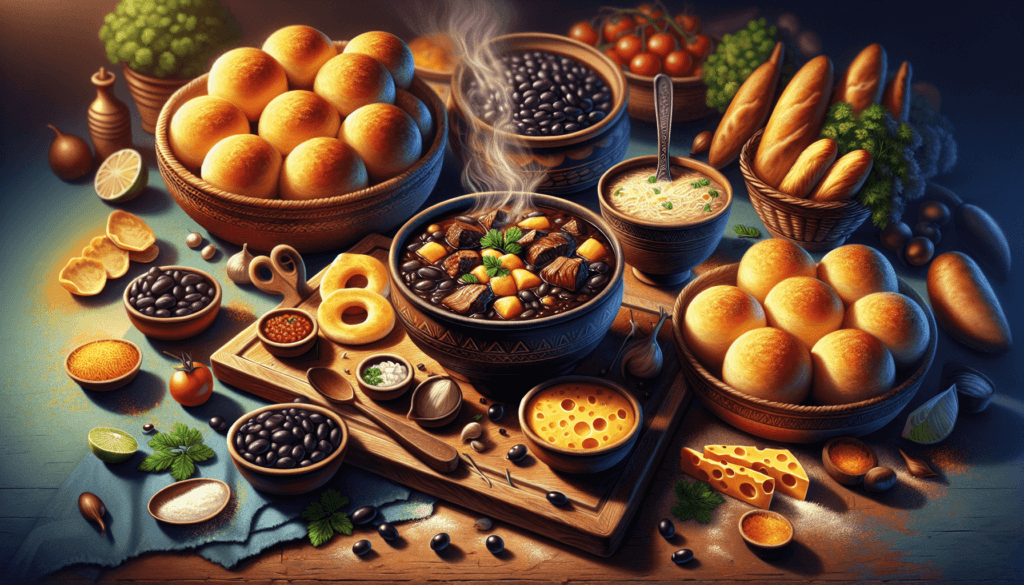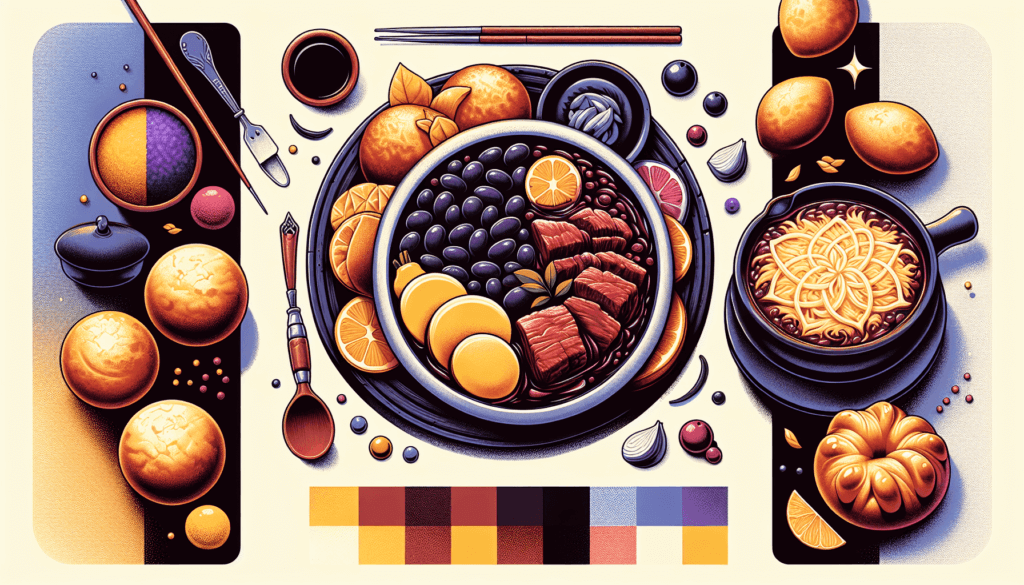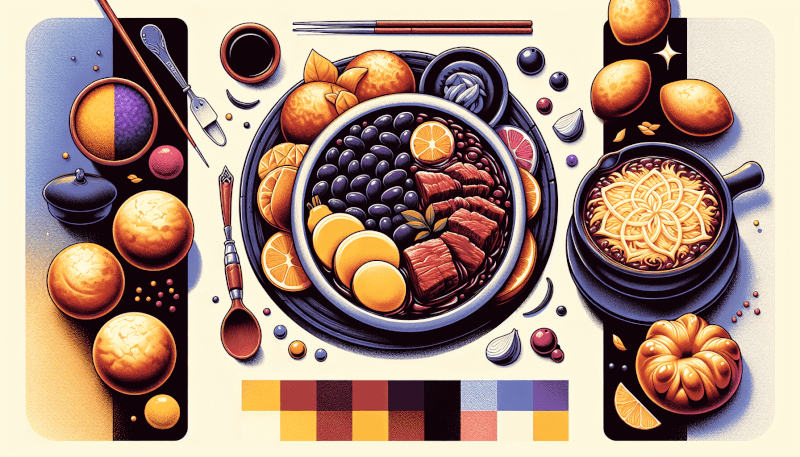Imagine sinking your teeth into a steaming plate of feijoada, a traditional Brazilian dish brimming with slow-cooked black beans, tender pork, and smoky sausage. As you savor each morsel, the flavors transport you to the vibrant streets of Rio de Janeiro, where the aroma of exotic spices fills the air. This is just a glimpse into the world of Brazilian comfort food, a cuisine that embraces bold and robust flavors, sure to warm your heart and tantalize your taste buds. Get ready to embark on a culinary adventure that will leave you craving for more.
Feijoada
Overview and History
Feijoada is a traditional Brazilian dish that is often considered the country’s national dish. It is a hearty and flavorful stew made with black beans and a variety of meat, such as pork, beef, and sausage. Feijoada has deep roots in Brazilian history and is closely associated with the country’s colonial past.
Ingredients and Preparation
To make feijoada, you will need ingredients such as black beans, pork ribs, smoked bacon, sausage, and beef. The dish also typically includes garlic, onions, bay leaves, and various spices. The preparation of feijoada is a labor of love, as it requires long hours of slow cooking to allow the flavors to meld together. The black beans are soaked overnight and then cooked with the meat until everything is tender and the flavors have come together.
Serving and Accompaniments
Feijoada is traditionally served with white rice, collard greens, and farofa, which is a toasted manioc flour mixture. The collard greens are usually thinly sliced and sautéed with garlic for added flavor. The farofa adds a delightful crunchy texture to the meal. Feijoada is often enjoyed with a caipirinha, a refreshing Brazilian cocktail made with cachaça, lime, and sugar. It is best enjoyed with friends and family, as it is a meal meant to be shared and savored together.
Coxinha
Overview and History
One of the most beloved Brazilian snacks, coxinha is a deep-fried pastry filled with shredded chicken. It is shaped like a drumstick, hence the name “coxinha,” which means “little thigh” in Portuguese. Originally created in São Paulo, coxinha has become popular all over Brazil and is often found at parties, celebrations, and street food stalls.
Ingredients and Preparation
The dough for coxinha is made with a combination of cassava flour, wheat flour, chicken broth, and butter. It is shaped into small, oval discs and filled with cooked and seasoned shredded chicken. The filled dough is then dipped in beaten egg, coated in breadcrumbs, and deep-fried until golden brown.
Popular Variations
While the traditional coxinha is filled with shredded chicken, there are also variations available. Some popular variations include coxinha de frango com catupiry (chicken with catupiry cheese), coxinha de calabresa (sausage), and coxinha de queijo (cheese). These variations add different flavors and textures to the classic coxinha, making it even more versatile and enjoyable.

Pão de Queijo
Overview and History
Pão de queijo, also known as Brazilian cheese bread, is a delightful snack and breakfast treat that originated in the state of Minas Gerais. Made with cassava flour and cheese, pão de queijo has a unique texture that is crispy on the outside and chewy on the inside. It is a staple in Brazilian cuisine and is loved by people of all ages.
Ingredients and Preparation
To make pão de queijo, you will need cassava flour, cheese (usually a combination of Parmesan and mozzarella), eggs, milk, and oil. The ingredients are combined to make a dough, which is then shaped into small balls and baked until golden brown. The result is a warm and cheesy bread that is incredibly addictive.
Serving and Variations
Pão de queijo is commonly enjoyed as a snack or for breakfast, often accompanied by a hot cup of coffee or tea. It can also be served as an appetizer or as part of a larger meal. While the classic pão de queijo recipe is delicious on its own, there are also variations available. Some popular variations include pão de queijo recheado (filled with various ingredients such as ham, bacon, or herbs) and pão de queijo doce (sweet cheese bread made with condensed milk).
Pastel
Overview and History
Pastel is a beloved Brazilian street food that consists of a thin pastry filled with a variety of ingredients. It is a popular choice for a quick snack or meal on the go. Originating from Portugal, pastel was brought to Brazil during the colonial period and has since become a staple in Brazilian cuisine.
Ingredients and Preparation
The pastry dough for pastel is made with flour, water, and a little bit of oil. It is rolled out into thin sheets and then filled with various ingredients. Some common fillings include ground beef, cheese, chicken, ham, and heart of palm. The filled pastel is then sealed and deep-fried until golden and crispy.
Traditional Fillings
While the filling options for pastel are endless, there are some traditional fillings that are particularly popular. Pastel de carne (beef) is a classic choice and is often seasoned with onions, garlic, and spices. Pastel de queijo (cheese) is another favorite, with a gooey and melty cheese filling. Pastel de frango (chicken) and pastel de palmito (heart of palm) are also commonly enjoyed options. The variety of fillings makes pastel a versatile and delicious street food.

Acarajé
Overview and History
Acarajé is a traditional street food from the northeastern state of Bahia, known for its rich and vibrant culinary heritage. It is made with black-eyed pea fritters that are deep-fried and then filled with a savory mixture of shrimp, vatapá (a spicy paste made from bread, shrimp, coconut milk, and various spices), and caruru (a sauce made from okra, dendê oil, and other ingredients).
Ingredients and Preparation
The main ingredient for acarajé is black-eyed peas, which are soaked and ground into a batter with onions and spices. The batter is then shaped into small balls and deep-fried until crispy on the outside and fluffy on the inside. Once the fritters are cooked, they are split open and filled with a generous amount of the shrimp, vatapá, and caruru mixture.
Significance in Bahian Cuisine
Acarajé is not only a delicious snack but also an important cultural symbol in Bahian cuisine. It is closely associated with the Afro-Brazilian religious tradition of Candomblé and is often sold by Baianas de Acarajé, women dressed in traditional clothing who are skilled in the art of making acarajé. These women play an integral role in preserving the culinary traditions of Bahia and are an important part of the cultural fabric of the region.
Brigadeiro
Overview and History
Brigadeiro is a beloved Brazilian sweet treat that is often enjoyed at parties, birthdays, and celebrations. It is a small, chocolatey confection that has a fudgy texture and is rolled in chocolate sprinkles. Brigadeiro has a fascinating history and is deeply rooted in Brazilian culture.
Ingredients and Preparation
To make brigadeiro, you will need condensed milk, cocoa powder, butter, and chocolate sprinkles. The ingredients are combined in a saucepan and cooked over low heat, stirring continuously until the mixture thickens and pulls away from the sides of the pan. Once the mixture has cooled, it is rolled into small balls and coated in chocolate sprinkles.
Popular Occasions and Variations
Brigadeiro is a staple at Brazilian birthday parties and is often found on dessert tables at weddings and other special events. It is a nostalgic treat for many Brazilians and is deeply ingrained in childhood memories. While the classic brigadeiro is made with chocolate, there are also variations available. Some popular variations include brigadeiro de leite condensado (made with condensed milk) and brigadeiro de caipirinha (made with cachaça, lime, and sugar), adding a unique twist to the traditional recipe.
Moqueca
Overview and History
Moqueca is a flavorful Brazilian seafood stew that is typically made with fish, onions, tomatoes, garlic, and cilantro. It is a dish that is deeply rooted in the culinary traditions of coastal regions in Brazil. Moqueca is known for its vibrant colors, rich flavors, and hearty servings.
Ingredients and Preparation
To make moqueca, you will need ingredients such as fish (often varieties like snapper or grouper), onions, tomatoes, garlic, cilantro, coconut milk, and dendê oil (palm oil). The fish is marinated in lime juice, salt, and pepper, and then cooked in a fragrant and flavorful sauce made from the onions, tomatoes, garlic, and coconut milk. The dendê oil is added towards the end of the cooking process to give the moqueca its distinctive flavor and color.
Regional Variations
Moquecas can vary from region to region in Brazil, with each area adding its own unique touch to the dish. In Bahia, for example, moqueca often includes the use of dendê oil and spices like malagueta peppers, giving it a fiery kick. In Espírito Santo, moqueca is typically made with tomato sauce instead of coconut milk, resulting in a lighter and tangier version of the stew. These regional variations add diversity to the already vibrant Brazilian culinary landscape.
Mandioca Frita
Overview and History
Mandioca frita, also known as fried cassava, is a popular Brazilian side dish that is often enjoyed alongside meals. It is made from cassava root, a staple in Brazilian cuisine that is commonly used in a variety of dishes. Mandioca frita is loved for its crispy exterior and soft, starchy interior.
Preparation and Serving
To make mandioca frita, the cassava root is peeled, cut into strips, and deep-fried until golden brown and crispy. The result is a delicious and addictive side dish that pairs well with a variety of main courses. Mandioca frita is typically served hot, sprinkled with salt, and enjoyed alongside grilled meats, feijoada, or even as a snack on its own.
Accompaniments and Dips
Mandioca frita is delicious on its own, but it can also be taken to the next level with the addition of various accompaniments and dips. Some popular options include serving it with garlic butter, spicy mayonnaise, or Brazilian vinaigrette (a fresh salsa-like sauce made with tomatoes, onions, peppers, and vinegar). These dips add an extra layer of flavor and elevate the enjoyment of mandioca frita.
Cachorro-Quente
Overview and History
Cachorro-quente, also known as Brazilian hot dog, is a popular street food in Brazil. It is a delicious and satisfying option for a quick and filling meal. The name “cachorro-quente” translates to “hot dog” in Portuguese and reflects its American origins.
Ingredients and Assembly
The basic ingredients for a cachorro-quente include a hot dog bun, a grilled or boiled sausage, and a variety of toppings. Common toppings include ketchup, mustard, mayonnaise, corn, peas, cheese, and diced tomatoes. The assembly of a cachorro-quente is a personal choice, with each person adding their preferred combination of toppings to create their perfect hot dog.
Popular Additions and Toppings
While the classic cachorro-quente is delicious on its own, there are also popular additions and toppings that take it to another level. Some popular variations include adding a layer of mashed potatoes to the hot dog bun, sprinkling crushed potato chips on top for extra crunch, or even adding bacon and caramelized onions for a gourmet twist. These additions and unique toppings add a burst of flavor and make each cachorro-quente a unique culinary creation.
Pudim de Leite
Overview and History
Pudim de leite, also known as Brazilian flan or caramel custard, is a classic Brazilian dessert that is loved for its creamy texture and rich flavor. It is a popular choice for celebrations and special occasions and is a sweet indulgence that never fails to satisfy.
Ingredients and Preparation
To make pudim de leite, you will need ingredients such as sweetened condensed milk, milk, eggs, sugar, and vanilla extract. The caramel sauce that tops the flan is made by melting sugar until it becomes a rich golden color. The custard mixture is made by combining the condensed milk, milk, eggs, and vanilla extract and then pouring it over the caramel sauce. The dessert is then baked in a water bath until set and chilled before serving.
Serving and Variations
Pudim de leite is typically served chilled and is often enjoyed on its own, as it is a dessert that is delicious in its simplicity. However, there are also variations that add different flavors to the classic recipe. Some popular variations include pudim de leite condensado com ameixa (with prunes), pudim de leite condensado com coco (with coconut), and pudim de leite condensado com chocolate (with chocolate). These variations add a unique twist to the traditional flan and cater to different tastes and preferences.
In conclusion, Brazilian comfort food offers a wide array of delicious and flavorful dishes that are deeply rooted in the country’s rich history and diverse culinary traditions. From the hearty and savory feijoada to the sweet and indulgent brigadeiro, these dishes are not only a delight for the taste buds but also a celebration of Brazilian culture and heritage. Whether you’re enjoying these dishes at a traditional feast or from a street food stall, they are sure to bring comfort and joy to your dining experience. So don’t hesitate to dive into the world of Brazilian comfort food and discover the flavors that have captivated the hearts of millions.


